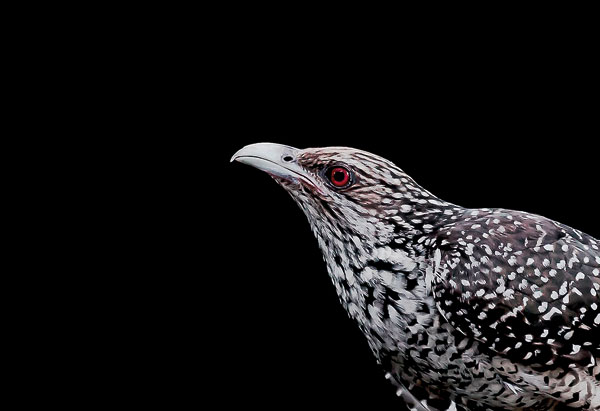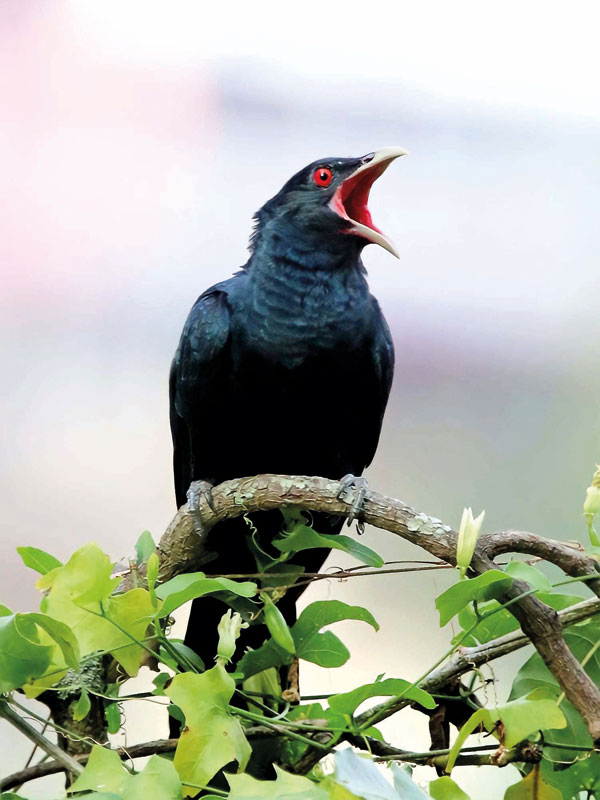News
The koha’s song – are we hearing it less during Avurudu?
View(s):By Malaka Rodrigo
The koha’s song, renowned for being the melody of ‘Avurudu’, traditionally heralds the arrival of the Sinhala and Tamil New Year. However, there’s a growing concern that this iconic trill is now less frequently heard during the season.
Could this be attributed to a decrease in the koha population, a shift in its singing season? Or is it our modern habits of spending more time indoors, engrossed in electronic devices, that cause us to miss out on this beautiful song?
The koha’s call was heard less during the Avurudu week, observed Jagath Gunawardane, a senior environmental lawyer and an ardent birdwatcher who has followed this bird’s patterns for decades. “But the kohais around us and its song was heard more toward the end of March this year, expecting to peak again towards the end of April or May.”

The female Asian Koel with its white and buff spots
Koha, also known as kovula in Sinhala, is the Asian koel (Eudynamys scolopaceus), a bird of the cuckoo family. The male is characterised by its glossy bluish-black plumage and striking red eyes that contrast with its overall appearance. The female Asian Koel displays a distinct appearance, featuring white and buff spots on its brownish upper body, while its underparts are more whitish.
Contrary to common belief, the koha, or Asian koel, is not a migratory bird to Sri Lanka. It is a breeding resident that can be seen throughout the year. The male koel is responsible for the melodious song. It is a courtship display aimed at winning a mate during breeding season that typically aligns with the onset of the Avurudu season.
There can be numerous factors influencing the traditional timing of the koel’s song, such as climate, said Mr. Gunawardane. He also noted an intriguing aspect: the crow can surprisingly influence the timing of this beautiful melody.
Asian koels, like many others of the cuckoo family, are brood parasites–meaning they do not build nests but lay eggs in the nests of other birds. “Asian Koels typically select nests of either of the two crow species as foster parents for their offspring,” Mr. Gunawardane explained. “Therefore, they wait until crows’ breeding season before initiating their own breeding rituals. If crows in an area begin building nests earlier, the koels may also begin their melodious songs in order to attract a mate.”
“Crows typically nest twice annually, but with the increasing crow population in urban areas, fuelled by ample garbage as a food source, they may breed thrice,” said Mr. Gunawardane. “This extended breeding season provides the koels with more opportunities to raise their offspring. As a result, there is a second peak of the Asian koel’s song towards August.”
Mr. Gunawardane addressed a common misconception, stating, “It is widely believed that the koel population has declined, leading to fewer instances of hearing their melodious song. However, experts argue otherwise.” Mr. Gunawardane himself observed five male koels singing during the peak of their breeding season from his residence in Nugegoda, indicating a healthy population.
Mr. Gunawardane has diligently recorded the times when the koha first begins its seasonal song and when it peaks. The journey started in 1974 out of personal interest, and now spans 50 years.
Reflecting on his early days of birdwatching, Mr. Gunawardane shared, “When I was in grade 9, studying at Ananda College and residing in its hostel, there was a jakfruit tree in front of our hostel where crows would build nests every year. Witnessing the common sight of koha babies in their nests piqued my curiosity, and observing them became a way to pass the time when there was nothing else to do.”
This humble beginning sparked a lifelong passion for observing and studying birds, particularly the enchanting koha. Mr. Gunawardane recalled a nest housing three crow fledglings alongside four baby koels.
“This nest was so crowded that sometimes birds did not have enough space and fell down. The little koels, larger than their crow siblings, could somehow climb back, but the students had to scale the tree to put back fallen crow fledglings,” Mr. Gunawardane recounted.

The male is characterised by its glossy bluish-black plumage and striking red eyes
Such casual observations possess scientific value and can contribute significantly to species conservation. “We are often excited about rare migrants or sightings of vagrants, but paying attention to common birds around us is also crucial,” remarked Prof. Nihal Dayawansa of the University of Colombo. He made these remarks at an event organised by the Field Ornithology Group of Sri Lanka (FOGSL) to celebrate World House Sparrow Day, which fell on March 20.
“Once very common, the house sparrow population worldwide has recorded a sharp decline in most areas. This serves as an example that even common birds can face decline due to various factors. However, such trends can be identified through observation of birds around us, recording them, and sharing findings,” said Prof. Dayawansa at the World Sparrow Day event.
In line with their commitment to the study of birds in Sri Lanka, FOGSL organised a Citizen Science programme called Avurudu Bird Count (ABC2024) to promote birding throughout the month of April. Participants are tasked with observing birds in their vicinity, entering the data into the eBird app, and sharing it with FOGSL.
“Citizen Science projects around the world are increasingly being utilised in scientific studies,” noted Prof. Dayawansa, who is also the president of FOGSL. He invites Sri Lankans to participate in this event, highlighting how Mr. Gunawardane’s personal observations of Koha over the years can contribute to understanding changes in its singing season.
For more information about the Avurudu Bird Count, individuals can reach out via email at fogsl1976@gmail.comor by calling 0789330076.
The best way to say that you found the home of your dreams is by finding it on Hitad.lk. We have listings for apartments for sale or rent in Sri Lanka, no matter what locale you're looking for! Whether you live in Colombo, Galle, Kandy, Matara, Jaffna and more - we've got them all!

